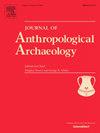Unveiling social identification, shared social identity, and collective memory as collective resilience factors: Insights from the Kura-Araxes diaspora
IF 2.2
1区 社会学
Q1 ANTHROPOLOGY
引用次数: 0
Abstract
During and after migration, communities can experience adaptive processes leading to collective resilience. Such processes are shaped by the challenges these communities face in adjusting to new social contexts, cultural backgrounds, and occasionally new environmental conditions. Undergoing a relocation process outside of a homeland, namely in a diaspora, is a strenuous venture. On the one hand, social psychological research shows that the loss of a close-knit community, once strongly attached to a social and natural environment, can leave individuals in precarious physical and mental states. Resilience research, on the other hand, demonstrates that specific resilience factors, such as social identification and shared social identity, strengthen communities affected by relocation, thereby buffering the negative effects on physical and mental health.
In an interdisciplinary effort, this study integrates archaeological evidence with theories from social psychology and resilience research to explore long-term mechanisms of collective resilience. Focusing on the Early Bronze Age Kura-Araxes society–one of the largest prehistoric diasporic communities in southwest Asia during the mid–fourth millennium BCE–we examine how material culture contributed to sustaining group cohesion and resilience in diasporic contexts. Our analysis demonstrates that social identification, shared social identity, and collective memory among Kura-Araxes communities functioned as resilience-enhancing factors over time. These findings deepen current understandings of collective resilience processes and open new avenues for investigating material culture as an agent of resilience. Moreover, the study highlights the potential for interdisciplinary collaboration to inform both archaeological interpretation and contemporary discussions on community resilience in the face of displacement and stress.

揭示社会认同、共同社会认同和集体记忆作为集体恢复力因素:来自库拉-阿拉克斯散居的见解
在移民期间和之后,社区可以经历适应过程,从而形成集体复原力。这些过程是由这些社区在适应新的社会背景、文化背景和偶尔的新环境条件时所面临的挑战所塑造的。在祖国之外经历重新安置的过程,即散居,是一项艰苦的冒险。一方面,社会心理学研究表明,失去一个紧密联系的社区,一旦强烈地依附于社会和自然环境,会使个人处于不稳定的身心状态。另一方面,弹性研究表明,特定的弹性因素,如社会认同和共同社会认同,加强了受搬迁影响的社区,从而缓冲了对身心健康的负面影响。本研究将考古学证据与社会心理学和心理弹性研究的理论相结合,探索集体心理弹性的长期机制。聚焦于青铜时代早期的库拉-阿拉克斯社会——公元前四千年中叶西南亚最大的史前散居社区之一——我们研究了物质文化如何在散居背景下维持群体凝聚力和弹性。我们的分析表明,随着时间的推移,库拉-阿拉克斯社区之间的社会认同、共同的社会认同和集体记忆发挥了增强复原力的作用。这些发现加深了目前对集体弹性过程的理解,并为研究物质文化作为弹性的代理人开辟了新的途径。此外,该研究强调了跨学科合作的潜力,为面对流离失所和压力的社区恢复力的考古解释和当代讨论提供了信息。
本文章由计算机程序翻译,如有差异,请以英文原文为准。
求助全文
约1分钟内获得全文
求助全文
来源期刊

Journal of Anthropological Archaeology
Multiple-
CiteScore
4.00
自引率
11.10%
发文量
64
期刊介绍:
An innovative, international publication, the Journal of Anthropological Archaeology is devoted to the development of theory and, in a broad sense, methodology for the systematic and rigorous understanding of the organization, operation, and evolution of human societies. The discipline served by the journal is characterized by its goals and approach, not by geographical or temporal bounds. The data utilized or treated range from the earliest archaeological evidence for the emergence of human culture to historically documented societies and the contemporary observations of the ethnographer, ethnoarchaeologist, sociologist, or geographer. These subjects appear in the journal as examples of cultural organization, operation, and evolution, not as specific historical phenomena.
 求助内容:
求助内容: 应助结果提醒方式:
应助结果提醒方式:


